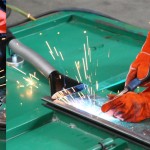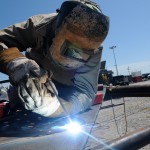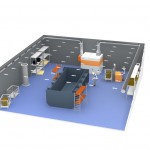Ventilation: more than an extension of spot extraction
Whether a displacement or a circulation system: ventilation is more than just a supplement to spot extraction. It also secures the occupational safety for surrounding work areas.
For occupational safety during welding, the following actually applies: the thicker the welding fumes that are collected at the point of origin, the better the chance of extracting all dangerous particles out of the workshop air. That’s why authoritative procedures say to collect contaminants directly at the point of origin. In terms of occupational safety for metalworking operations, the principle applies thus: priority goes to so-called spot extraction. A high degree of collection of hazardous dust particles that come from welding is guaranteed only in this way.
But in practice it often looks different. Small-component welds in multiple places make spot extraction impractical due to the constantly changing weld locations. Also when welding large workpieces, spot extraction is often not feasible. Because of the configuration of the workpiece, some weld locations can’t be reached at all by spot extraction. And if the welder doesn’t position it optimally, dust particles escape into the workshop.
Room ventilation systems close safety gaps
Room ventilation systems stop the leak at the immediate welding fume extraction site. When spot extractions are not practical, room ventilation is more than supplemental. In addition, room ventilation guarantees the protection of others in the vicinity of welding applications. While welders themselves are protected at the point of origin of welding fumes by special welding helmets with automatic ventilation and filtering, the welding fumes fill the surrounding area unhindered. Employees without breathing protection are exposed to damaging dust particles. Not only that, room ventilation also improves interior comfort by constantly moving the air, saving up to 70 percent in heating costs.
Circulation or displacement ventilation?
Companies have a choice between two types of room ventilation: circulated ventilation or displaced ventilation, also called layer ventilation. Both processes extract air at a height of four to six meters. With circulated ventilation, the purified air is blown out at a height of four meters through nozzles or vents. Thus all the air is mixed.
Displacement ventilation, however, supports the temperature of the welding fumes by supplying air from below. For this reason, the trade association also recommends this system. Clean air is quietly supplied to the workshop through outlets close to the floor in the welding work zone areas. The rising air supports the natural buoyancy of the welding fumes as they rise where they are supposed to. In this way the air quality improves in the area around the outlets and thus in the breathing area of the employees.





